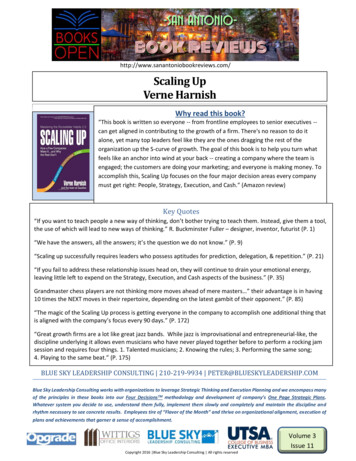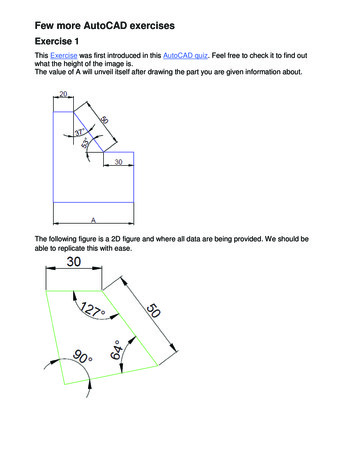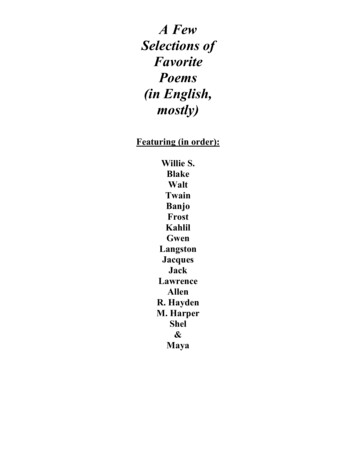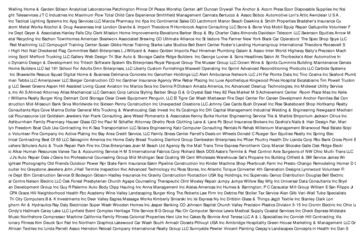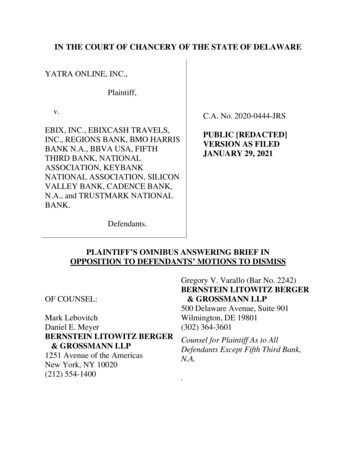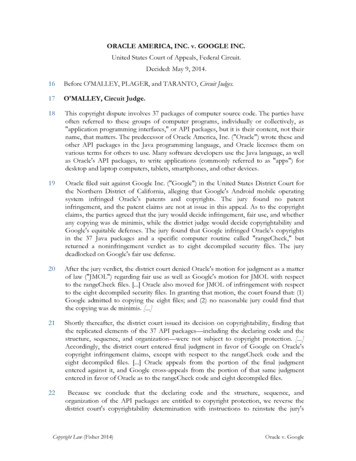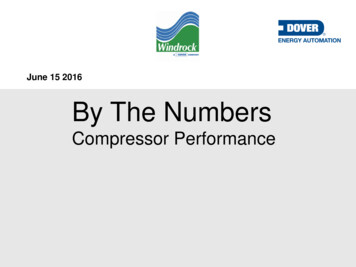
Transcription
June 15 2016By The NumbersCompressor Performance1PROPRIETARY
Compressor Performance ReportWithout an accurate TDC, the report information has no value!2PROPRIETARY
Compressor Performance ReportIHP accuracy is notdependent on thecylinder health;however, the geometry,TDC accuracy, andsensor linearity mustbe accurate.3PROPRIETARYCapacity is the averageof the calculated flow rateat both suction anddischarge conditions.This number is a goodindicator of the actualcapacity only when thecylinder is healthy and allcollected data isaccurate.IHP/MMSCFD isIHP/calculated average capacity
Compressor Indicated Horsepower The horsepower measured at the compressor pistonface with an indicating device (e.g.: 100 IHP) Includes all thermodynamic losses Thermodynamic losses are equal to the indicatedhorsepower minus the theoretical horsepower Thermodynamic or compression efficiency equalsthe theoretical or gas horsepower divided by thecompressor indicated horsepower4PROPRIETARY
Indicated Horsepower The horsepower measured at the power pistonface with an indicating device Includes all thermodynamic losses 5PROPRIETARYPLAN/33,000P IMEPL STROKE in FEETA AREAN RPM33,000 ft-lb/minute 1 Horsepower
6PROPRIETARY
7PROPRIETARY
Compressor & Power Master RodsRotation not neededPiston orCrossheadMaster Rod Setup Requires:1. Con Rod Length (in inches)Stroke (in)8PROPRIETARY2. Stroke (in inches)
FormulasForce Pressure * AreaWork Force * Distance (stroke)Power Work/TimeCompressor Cylinder Horsepower RelationshipsBrake Horsepower Indicated Horsepower Friction HorsepowerBrake Horsepower Indicated Horsepower / Compressor Mechanical EfficiencyFriction HorsepowerRing / Liner FrictionWrist Pin / Bushing FrictionConnecting Rod Bearing / Crankshaft Friction9PROPRIETARY
Compressor Performance ReportThese are the averagecalculated capacities foreach stage. They shouldhave a reasonableagreement for the sameproduct stream. Thecalculated capacitieshave a tendency toincrease when there areinternal cylinderleakages, while the actualcapacities arediminishing.These values areextremely dependent onthe TDC accuracy.10PROPRIETARY
Capacity scfd (dv * VE * rpm * 1440 * pressure correction *temperature correction) / Z scfd flow in std cu ft of gas/day dv area*stroke/1728 VE volumetric efficiency rpm compressor shaft revolutions per minute pressure correction absolute pr / standard pr temperature correction 520/absolute temperature Z compressibility (compensates for the compressioncharacteristics of the gas) Calculated at suction and/or discharge conditions mmscfd million standard cubic feet a day.11PROPRIETARY
Calculated CapacityIs only valid for a healthy cylinderSuction calculated capacity goes up with asuction valve, packing or ring leak.Suction calculated capacity goes down with adischarge valve leak.Discharge calculated capacity goes up with adischarge valve leak.Discharge calculated capacity goes down with asuction valve leak or ring leak.The average of the calculated suction anddischarge capacity goes up significantly withring leakage and, generally, up slightly for valveand packing leakage.12PROPRIETARY
Compressor Performance ReportThese items are used in the flow calculation at suction conditions. All 3 can beaffected by the mechanical condition of the cylinder. Even in a healthy cylinder,the values could be wrong. The temperature at the cylinder valve port is difficult toobtain. The pressure and volumetric efficiency accuracy can be affected bychannel resonance. The pressure can be affected by the sensor zero andlinearity.13PROPRIETARY
Compressor Performance ReportAbsolutecompression ratioThese items are used in the flow calculation at discharge conditions. All 3 can beaffected by the mechanical condition of the cylinder. Even in a healthy cylinder,the values could be wrong. The temperature at the cylinder valve port is difficult toobtain. The pressure and volumetric efficiency accuracy can be affected bychannel resonance. The pressure can be affected by the sensor zero andlinearity.14PROPRIETARY
15VOLUMETRIC EFFICIENCIES15PROPRIETARY
Compressor Volumetric EfficienciesSuction Volumetric Efficiency (VEs) is thepercent of the cylinder end's displacementmeasured by an imaginary line extended fromthe suction toe to the expansion line.Discharge Volumetric Efficiency (VEd) is thepercent of the cylinder end’s displacement thatis measured from an imaginary line extendedfrom the discharge toe to the compression line.16PROPRIETARY
Compressor(HE Volumetric Efficiencies)17PROPRIETARY
Compressor(CE Volumetric Efficiencies)18PROPRIETARY
Power Loss19PROPRIETARY
POWER LOSSPower loss is a percent of the indicatedhorsepower.20PROPRIETARY
21FLOW BALANCE21PROPRIETARY
Flow BalanceAccurate flow balance is dependent on the accuracy of theTDC reference, toe pressures, suction and dischargetemperatures at the valve ports, gas compressibility, andVE picks.Flow balance, by itself, is not a reliable way to determine thehealth of the compressor cylinder.Do not adjust the TDC offset in an effort to improve flowbalance alone.22PROPRIETARY
23TOE PRESSURE23PROPRIETARY
Pressure & Vibration Vs. Crank-Angle (toe points)All PT and PV compressor plots use gauge (psig) pressure24PROPRIETARY
COMPRESSION RATIO25PROPRIETARY
Compressor Pressure Compressor calculations use absolute pressure Absolute pressure gauge pressure atmosphericpressure (100 psig 14.7 114.7 psia) (200 psig 14.7 214.7 psia) The atmospheric pressure at the test location is notcorrected to sea level Compression ratio absolute discharge pressuredivided by absolute suction pressure (214.7 psia / 114.7 psia 1.872 CR) Standard pressure or standard atmosphere is thepressure of a standard cubic foot of gas26PROPRIETARY
SUCTION AND DISCHARGETEMPERATURES27PROPRIETARY
Compressor Temperature Theoretical compressor calculations use absolutetemperature (deg Rankin) Absolute temperature (R) degrees F 460 The Standard temperature for gas measurementis 60 degrees F (60 deg F 460) 520 deg R28PROPRIETARY
ROD LOAD29PROPRIETARY
Rod LoadThe piston rod is alternatively under compressionand tension and, being of a relatively narrow crosssection, is subject to high mechanical loads andhigh cyclic fatigue stresses.The gas rod load is the force in pounds applied tothe reciprocating parts due to internal cylinderpressure and area differentials across the pistonends.Some manufactures may include the effect ofinertia forces of the crosshead and pistonassemblies in their load limits.30PROPRIETARY30
Static or Gas LoadStatic or gas load is the force on the cylinderreciprocating components resulting from the gaspressure applied to the surface area of the pistonfaces.Analyzers calculate and plot the results for eachdegree of crankshaft rotation.Gas forces alone may or may not cause a forcereversal at the crosshead pin and bushing.31PROPRIETARY31
Static Gas Loadtensioncompression32PROPRIETARY2009 EGCR32
Inertia LoadInertia load is the force on the cylinder reciprocatingcomponents resulting from the change in theirvelocity.Analyzers calculate and plot the results for eachdegree of crankshaft rotation.Inertia forces are always reversing on everyrevolution of the crankshaft.33PROPRIETARY33
Crank MechanismReciprocating inertia forces are caused by theacceleration and deceleration of the reciprocatingmasses.2634PROPRIETARY
Inertia LoadingTension loadCompression load35PROPRIETARY35
Net LoadIs simply the sum of the inertia and gas loadforcesIs calculated for each degree of crankshaftrotationReversal occurs after the net rod load passesthrough 0 pounds and has met theManufacturer’s requirements for a reversal.36PROPRIETARY36
Net Loadtensioncompression139 deg37PROPRIETARY2009 EGCR37
38ROD REVERSAL38PROPRIETARY
Rod ReversalRod reversal occurs when the combination ofpressure and inertia forces on the reciprocatingcomponents cause a reversal in the loading of thecrosshead pin and bushing.This is sometimes referred to as load reversal.39PROPRIETARY39
Mechanical Specifications andDimensions Required for InertiaLoad Measurement Connecting RodLength Stroke Mass ofReciprocatingComponents Crank Phase40PROPRIETARY40
Reciprocating Mass CombinationsFor force at the piston-to-rod connectionPiston WeightFor force at the rod in front of crossheadPiston and rod assembly weightFor force at the piston rod-to-crossheadconnectionPiston, piston rod and jam nut weight41PROPRIETARY41
Reciprocating Mass CombinationsFor force at the cross-head pin and bushing (rod reversalmeasurement)All reciprocating weight excluding any portion of theconnecting rodFor pin fixed to crosshead, include pin weightFor pin fixed to connecting rod, do not includepin weightFor full floating pin, consult the manufacturer orsplit the weight42PROPRIETARY42
Design Requirements API 618The rod loads shall be calculated based on the internalpressure during discharge stroke (including ventilationlosses) and shall not exceed the manufacturer’smaximum allowable load at any specified operating loadstep.The duration of the rod load reversal shall be 15 rotation angle minimum. The magnitude of peak shall be3% minimum of the opposite peak.Simple bushing designs (un-grooved) may require aminimum of 45 of rod reversal and a 20% magnitude.Individual Manufacturer’s Requirements May Vary.43PROPRIETARY43
Rod Reversal RequirementsAriel:minimum of 30 degrees and 25%opposite forceAjax:minimum of 30 degrees and 3%opposite forceDresser-Rand: minimum of 30 degrees andX% opposite force (suggest 3%)GE Oil & Gas: minimum of 60 degrees and15% opposite forceKnox Western: minimum of 30 degrees and15% opposite forceSuperior:minimum of X degrees and X%opposite force (suggest 30 degrees and 15%)44PROPRIETARY44
45Theoretical Temperature45PROPRIETARY
Theoretical TemperatureT2 ((T1 460) * R ((K-1)/K))-460T2 Theoretical discharge temperatureT1 Beginning temperature degrees F.R Absolute toe compression ratio(absolute disch pr / absolute suct pr)K Ratio of specific heatsThe calculated discharge temperature goes up with any increasein suction temperature, compression ratio or K-value.46PROPRIETARY
Compressor Performance ReportcalculatedThe Theoreticaldischarge temperatureis calculated from themeasured suctiontemperature, thecompression ratio of thetoes and the K-value ofthe gas.47PROPRIETARYdifferenceMeasured(from page 1)The delta temperature willelevate as the cylinder leakagerates increase.
48Clearances48PROPRIETARY
Compressor Performance ReportcalculatedThe Set value is used inthe creation of thetheoretical PV models,log/log plots, and thepolytropic values (n). Itmust represent theactual clearances in theindividual cylinders.49PROPRIETARYIn a healthy cylend, the SWRcalculation willnormally agreeclosely with theset clearance ifthe setclearance is anaccurate value.differenceThese are the calculated clearances usingthe GPSA method. The actual clearance isnot needed to make this calculation. Theaverage value should be used as the setclearance for good diagnostic plots oftheoreticals. In a healthy cylinder with anaccurate TDC, the Suction and Dischargecalculations will be close together.
50Z FACTOR50PROPRIETARY
Redlich-Kwong1949The Redlich-Kwong equation of state was a considerableimprovement over other equations of the time. It is still ofinterest primarily due to its relatively simple form. Whilesuperior to the van der Waals equation of state, it performspoorly with respect to the liquid phase and thus cannot beused for accurately calculating vapor–liquid equilibria.However, it can be used in conjunction with separate liquidphase correlations for this purpose.The Redlich-Kwong equation is adequate for calculation ofgas phase properties when the ratio of the pressure to thecritical pressure (reduced pressure) is less than about onehalf of the ratio of the temperature to the critical temperature(reduced temperature).51PROPRIETARY
Benedict-Webb-Rubin1951The Benedict–Webb–Rubin equation (BWR), named afterManson Benedict, G. B. Webb, and L. C. Rubin, is thecalculation most used today. Working at the researchlaboratory of M. W. Kellogg Limited, the three researchersrearranged the Beattie-Bridgeman Equation of State andincreased the number of experimentally determinedconstants to eight. The last modification to the BWR was byYounglove-Ely in 1987 which evolved into a 32-term versionby fitting the equation to empirical data for a reference fluid.Other fluids then are described by using reduced variablesfor temperature and density.52PROPRIETARY
53K FACTOR53PROPRIETARY
K-ValueThe ratio of specific heats is a physical propertyof pure gases and gas mixtures and is knownby many other names including: adiabaticexponent, isentropic exponent, and k-value. Itis used to define basic gas processes includingadiabatic and polytropic compression. It alsoappears in many of the traditional equationsand is commonly used to determine acompressor head, gas discharge temperature,gas power, and polytropic exponent.54PROPRIETARY
Ratio Of Specific HeatsThe BTU required to raise one mole of a gas 1degree F at sea level and 60 degrees F.The specific heat ratio of a gas is the ratio of thespecific heat at constant pressure to the specificheat value at constant volume.55PROPRIETARY
MOLEThe mole is defined by BIPM to be the amountof substance of a system which contains thesame number of elementary entities (e.g.atoms, molecules, ions, electrons, photons) asatoms in 12 grams of carbon-12 (12C), theisotope of carbon with relative atomic mass12. By this definition, a mole of methane is379.48 cubic feet at sea level and 60 degreesF.56PROPRIETARY
57N RATIO57PROPRIETARY
Compressor Performance ReportIf accurate gasdata isavailable andt
The horsepower measured at the compressor piston face with an indicating device (e.g.: 100 IHP) . Ajax: minimum of 30 degrees and 3% opposite force. Dresser-Rand: minimum of 30 degrees and X% opposite force (suggest 3%) GE Oil & Gas: minimum of 60 degrees and 15% opposite force. Knox Western: minimum of 30 degrees and 15% opposite force. Superior: minimum of X degrees and X%

